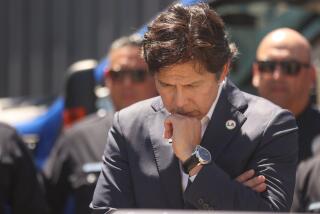Most Candidates Never Get Near a TV Camera
- Share via
With the sights and sounds of spot announcements abounding as the Nov. 6 election draws close, it is easy to exaggerate the importance of television in political campaigns. In a recent article about a Federal Communications Commission audit showing that television and radio stations
overcharge for political commercials Thomas B. Rosenstiel wrote that “the largest single campaign cost is television time.” A study I have just completed demonstrates that this statement is widely off the mark, at least insofar as campaigns for most state and local offices are concerned.
Independently, the Television Bureau of Advertising estimated that in 1988, some $228 million was spent on political broadcast advertising and programs. The remarkable finding is that this represents only 8.4% of total political spending, which was $2.7 billion for the 1988 elections (when calculated to cover all political candidates, parties and committees seeking to influence electoral results, for nomination and election, at all levels--federal, state and local). This amount even includes the costs of ballot-issue campaigns.
According to the U.S. Census Bureau, in 1987 there were 504,404 popularly elected offices in the United States. Most of the candidates for these offices never buy any television time nor even get near a television camera. Usually only serious candidates for major offices--presidential, senatorial, gubernatorial and mayoral in big cities--make substantial use of television advertisements. Probably only about half of the House candidates purchase television time, and its cost often represents only a small portion of their campaign spending, which is mainly on fund-raising, direct mail, salaries for staff, fees for consultants, travel, office rentals, equipment and supplies. Far more is spent on each of two categories than on television: registering people and getting them out to vote on election day, and staff salaries and fees.
House candidates whose districts are covered by the costliest media markets--such as New York City, covering 40 congressional districts in a tri-state area--are more likely to spend their money on direct mail rather than buy television time that blankets not only their district but sections of huge metropolitan areas whose residents are unable to vote for the candidate. For most House, state legislature, county and municipal campaigns, television simply is not cost-efficient.
Even in races for some major offices, including the presidency, in which television advertising is essential, the extent of its use varies according to campaign strategy and circumstances.
Robert Squier, a prominent political consultant who generally works for candidates who have serious competition, says this about broadcast costs: “Our rule of thumb is that half the campaign money goes to paid media, and with our fee, it goes up to about 60%.” This is a correct statement for most seriously contested U.S. Senate or gubernatorial campaigns. In the 1986 California campaign, Sen. Alan Cranston spent $6.2 million on television time and $800,000 on commercial production costs, 57% of the $12.3 million he spent. Cranston’s opponent, Ed Zschau, spent $6.5 million on broadcast time alone, more than half his campaign’s total expenditures.
Candidates who use television advertising do so primarily for two reasons: They find it cost-effective, and they believe it works. This is so for heated campaigns for major office, mainly general-election ones. Even in these categories, some want to use television but cannot afford it. Some incumbents run with minimal serious opposition.
It is misleading to think only of major statewide campaigns where television costs can be substantial, for example, in California, in covering the 12 major media markets. But for most political campaigning, which is local, television has hardly changed the face of American politics.
More to Read
Get the L.A. Times Politics newsletter
Deeply reported insights into legislation, politics and policy from Sacramento, Washington and beyond. In your inbox twice per week.
You may occasionally receive promotional content from the Los Angeles Times.










